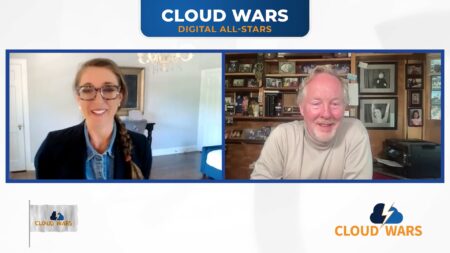After 30 years of being not only unquestionably essential but also relentlessly boring, the cloud is transforming the ERP market into a wildly disruptive source of intelligence that is beginning to harness the power of machine-learning algorithms to turn the world of traditional business upside-down.
Imagine being able to:
- eliminate 50% of all of your business processes in 3 years or less;
- reallocate resources away from low-value work and toward customer-facing growth opportunities;
- fuse demand data with procurement data to enable high-profit dynamic pricing; and ultimately
- move at the speed of your customers and prospects.

Welcome to the mad-science laboratory of Franck Cohen. Cohen is President of SAP Digital Core & Industry Solutions and a long-time player in the ERP market—and the best thing about Cohen’s lab is that it extends out to and incorporates real-life transformations happening in several thousand businesses and across every industry.
“ERP was pretty boring for 29 years but now it’s getting really exciting,” Cohen said in a recent 1:1 interview at SAP’s stunning offices atop Manhattan’s Hudson Yards.
“In the early days, cloud computing was not there, artificial intelligence was not there, machine learning was not there—but now they are here, and it’s time to build a complete new generation of best practices for business on top of those new technologies.”
Armed with a revolutionary’s mindset and close relationships with thousands of big and mid-sized corporations around the world, Cohen has become a zealot for radical approaches to business that, paradoxically, the earliest generations of SAP applications helped cement into place.
Of the many big ideas Cohen shared during our discussion, here are the two that made the biggest impact on me:
- The race to 500 machine-learning algorithms. Cohen’s passionate belief is that machine-learning algorithms will transform the business world in ways that are now almost impossible to fathom. “We’re in the middle of a global customer council meeting, and this morning I told the group that in February 2017, we had one—just one—machine-learning algorithm. Now today, we have 56—and I promised our customers that we will have more than 200 at the end of 2019, and 500 at the end of 2020. And then of course I told them where we are heading: we are using artificial intelligence to deliver the world’s first hands-free ERP: you do everything with your voice—you don’t use the keyboard anymore. And they all loved that.”
- The pace of cloud innovation must not slow down. Cohen said SAP has been pumping out quarterly releases of new cloud features with a minimum of 20% more functionality per release—and as challenging as it has been for SAP’s cloud ERP customers to absorb that into production, they shouted down Cohen’s suggestion that SAP could moderate its pace of innovation. “For them to absorb all that, and to do all the necessary testing before going into production, this represents a huge amount of effort on their part.” So when Cohen proposed that SAP moderate those enhancements to 2 releases per year, “I was so surprised because they said, ‘We love the pace of innovation, we love the challenge to get all that new functionality every quarter—so DO NOT slow down!’ And I was shocked.”
Those customers clearly understand that as challenging as keeping up with the quarterly releases has proven to be, it is infinitely superior to falling steadily behind their more-aggressive competitors and becoming increasingly irrelevant to their more-demanding customers.
In the context of that type of aggressive and uncompromising outlook, it feels almost normal to hear Cohen say that by 2025—just six short years from now—65% of the manual processes that make up so much of today’s endless business activity will be gone, kaput, eliminated.
“You have an engine calculating the price, the volume capabilities, and the delivery,” Cohen said in his staccato French-accented English, “and you have to plan for the production, connect with the manufacturing schedule, and procurement and so on.
“So let me ask you—from a business-process point of view, why would you have anything manual in there? The only need for manual intervention is if there are exceptions, if something is going wrong—otherwise, you have to think that all of your processes—all of them—will be fully automated,” he said, rising from his chair and pacing the room.
“So what you then need to do is connect the dots—digitally—between all of these different points with the right intelligence to make sure it’s completely fluid. But as for manual process, there is nothing for them—there is no need for them!”
And if—well, when—that end-to-end digital enterprise comes to pass, the financial impact from this new wave of machine-learning algorithms will be staggering, says Cohen.
“Simply replacing rules-based algorithms that are static with machine-learning algorithms that are learning all the time is going to create huge value.
“I’m talking billions.”
So goodbye, killer apps—and hello, killer algorithms. And be sure to lace ’em up tight, folks—looks like the Cloud Wars are going to become even more intense in 2019.
Disclosure: at the time of this writing, SAP is a client of Evans Strategic Communications.

*******************
RECOMMENDED READING FROM CLOUD WARS:
The World’s Top 5 Cloud-Computing Suppliers: #1 Microsoft, #2 Amazon, #3 Salesforce, #4 SAP, #5 IBM
Amazon Versus Oracle: The Battle for Cloud Database Leadership
As Amazon Battles with Retailers, Microsoft Leads Them into the Cloud
Why Microsoft Is #1 in the Cloud: 10 Key Insights
SAP’s Stunning Transformation: Qualtrics Already “Crown Jewel of Company”
Watch Out, Microsoft and Amazon: Google Cloud CEO Thomas Kurian Plans To Be #1
The Coming Hybrid Wave: Where Do Microsoft, IBM and Amazon Stand? (Part 1 of 2)
Oracle, SAP and Workday Driving Red-Hot Cloud ERP Growth Into 2019
*********************








